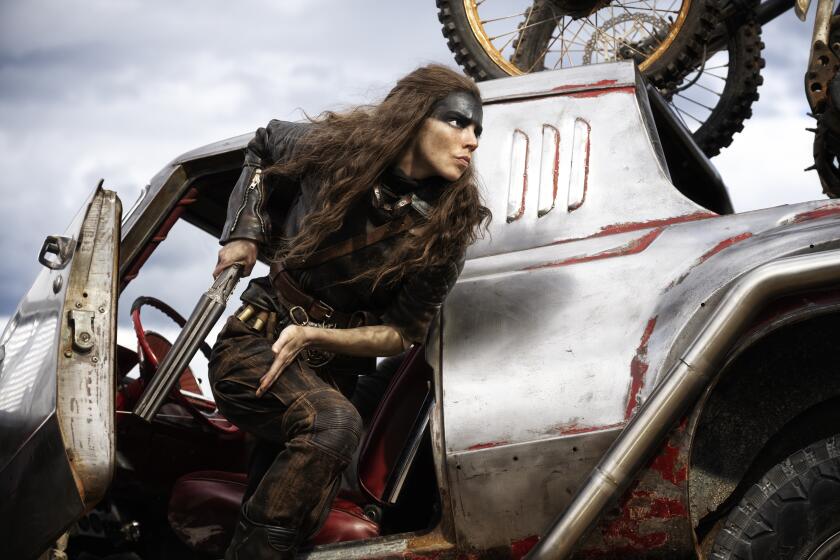The Cutting Edge: Computing / Technology / Innovation : Hollywood Moves Toward Digital Standard : Film: Getting away from negatives will make it easier to duplicate movies, as well as revolutionize the studios’ archives.
Lou Levinson, a color specialist at MCA/Universal Inc., recalls with little nostalgia his many years in the trenches of movie post-production, converting film negatives into video images that could be shown on television screens around the world.
“If you’re working with a good movie, that’s fine, but a bad movie is torture,” says Levinson, whose credits include “E.T.” and “Raiders of the Lost Ark.” “With a bad film, you can go so brain-dead it takes a tremendous amount of self-discipline to do a quality job.”
That’s because a telecine colorist--a telecine is the machine that converts film to video--must scan the same film up to eight times to make it available in all of the television formats now used around the world. It’s painfully repetitive--and expensive. The first pass can take 30 hours or more, at up to $500 an hour.
But with new European, American and Japanese high-definition television systems threatening to create the need for even more of the same, film studio engineers have joined forces to create a method for transforming film negatives to the ones and zeros of the Information Age.
Their goal: to create an electronic workhorse for the industry called the “digital film master,” or DFM. If successful, the effort will not only make life easier for post-production workers, it will also result in a digital film standard that could revolutionize the way Hollywood film archives are managed.
With a digital duplicate of a film’s original negative, a computer workstation can be used to transform the images, quickly and economically, into virtually any viewing format. Thousands of formatted master tapes that now need to be stored and maintained--and are vulnerable to fading, fires and other dangers--would no longer need such vigilant protection.
“Studios feel possibly if they can get a digital representation of the film more akin to a computer data storage tape, it might allow them a more secure and pristine representation of their investment,” says M. Michael D’Amore, vice president of business development at Simi Valley-based BTS Broadcast Television Systems Inc., one of the key technology companies involved in the project.
The digital film master could help film maintain its position as the industry’s production standard of choice in an era of steadily improving video technology and increasing use of computerized special effects.
Such effects must be reproduced on optical film before they can be edited into a motion picture, resulting in a loss of picture quality. With the DFM, however, movie makers could potentially create effects directly on the digital duplicate, thus gaining better resolution--and saving time and money.
“We thought if we could find a resolution high enough to capture everything that’s on the film, we should be able to take that one digital recording and make all the other versions we need,” says Christopher J. Cookson, senior vice president of technical operations for Warner Bros. “It’s just a matter of putting together the science that already exists with a different set of assumptions.”
With current technology, the process for converting a film into multiple video formats requires that a work negative, or “interpositive,” be struck from the original. It is then scanned through a telecine system that translates the picture into a digital recording. The telecine can output the image according to various specifications.
The process is repeated to conform to domestic and foreign transmission standards as well as the popular viewing formats: a “pan-scan” version that selectively frames a film’s wider image for TV; a “letterbox,” or smaller image, that retains a film’s original dimensions; and a wide-screen version for a new, increasingly popular type of European TV.
The Film Technology Council of the Motion Picture-Television Industry Assn., which is leading the effort, wants to streamline the process to a single scan. It believes this will be possible by stretching the limits of high-definition television. With an HDTV telecine system that corresponds closely to film’s 35-millimeter screen dimensions, high-resolution images can be scanned to a data storage system resembling a large videocassette.
But creation of a digital film master requires a recording unit with even more memory than an HDTV videocassette--no small challenge. So far, the only machine that comes close is an existing HDTV cassette recorder jointly developed by BTS and Toshiba Corp. of Japan.
After several months of testing by Warners’ Cookson and his team, the recorder is now being modified to expand its data storage capacity.
“I think we’ll get there within two years,” says D’Amore of BTS. There is no question in the minds of its innovators that DFM technology can work. But once it does, the group will face another challenge: making the system affordable by promoting its adoption as an industry standard.
“In order to bring down equipment costs, we would probably need the DFM to be accepted by film libraries industrywide,” says Richard Stumpf, Universal’s senior vice president of engineering and development. He estimates that each library will need to spend about $1.5 million to get the system up and running. “But some could share the same facility, and the post-production community might even want to offer this as a service,” he says.
To address those and other issues, the technology council invited representatives from 10 major film libraries to meet last year. According to Update, the trade group’s newsletter, the idea was met with “general enthusiasm.”
Creating a Digital Master
With the advent of high definition television and the proliferation of other new television formats around the world, film engineers are searching for a way to simplify the process of transferring film images to video. The creation of a Digital Film Master would eliminate the need to scan the film negative separately for each different video format, and could also be used to build secure and versatile digital film archives.
CREATING THE DIGITAL FILM MASTER
1. FILM NEGATIVE
A “work negative” is passed through the system. 2. FILM SCANNER
An HDTV telecine scanner transforms the film image into electronic video signals. 3. ELECTRONIC CONVERTER
The video signals are converted to the ones and zeros of computer code, using the special DFM format. 4. DIGITAL MASTER RECORDER
The information is stored on a modified HDTV videocassette. 5. DFM
The Digital Film Master is produced. * USING THE DIGITAL FILM MASTER 1. DFM
Information recorded on the Digital Film Master is outputted. 2. NOISE REDUCTION
Visual distortions or electronic “noise” is eliminated. 3. COLOR CORRECTION
The video image is adjusted look like film or to meet other specifications. 4. ELECTRONIC CONVERTER
A video format is selected. 5. FORMAT SELECTION
* U.S. Broadcast TV
* Foreign Broadcast TV
* Full Frame
* Pan-Scan
* Letterbox
* Widescreen TV
* European HDTV
* U.S. HDTV
* Japanese HDTV 6. MARKET-SPECIFIC VIDEOTAPE
A tape in the specified format is produced. 7. AUDIO - TITLES
Sound and titles are added to allow for foreign language versions.
Source: Film Technology Council of Motion Picture Television Industry Assn.
More to Read
The biggest entertainment stories
Get our big stories about Hollywood, film, television, music, arts, culture and more right in your inbox as soon as they publish.
You may occasionally receive promotional content from the Los Angeles Times.






